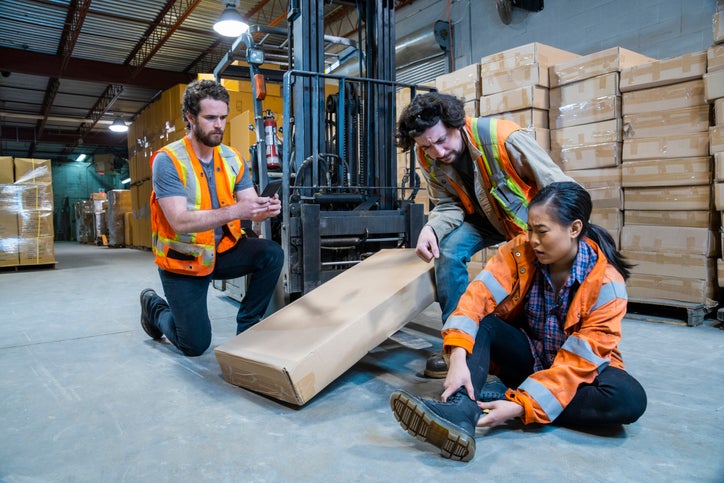Employee injury at work: A complete guide for UK small business owners
If an employee gets injured at work, your response as an employer can make all the difference – not just for the wellbeing of your staff, but also for your business. Knowing exactly what to do, what your legal obligations are, and how to handle the situation properly can feel overwhelming, especially just after a bad accident.
This guide walks you through what UK small business owners need to know about workplace injuries, from how to immediately respond to initiatives you can put in place to prevent future accidents.
We'll help you understand your legal responsibilities, how to support injured employees, and ways to create a safer working environment for everyone.

What are my legal obligations after an employee is injured at work?
As a business owners and UK employer, you have specific legal duties when a workplace injury occurs. Understanding what these obligations are will help you stay compliant and protect both your employees and your business.
Reporting requirements under RIDDOR
What is RIDDOR? It stands for the Reporting of Injuries, Diseases and Dangerous Occurrences Regulations (RIDDOR) and requires employers to report certain types of workplace incidents to the Health and Safety Executive (HSE).
It's your legal duty to report the following incidents:
- Incapacitation from work — If an injured employee is unable to attend work or perform their normal duties for more than seven consecutive days as a result of their injury, this must be reported.
- Specific injuries — These include but are not limited to:
- Amputations.
- Fractures, other than to fingers, toes and thumbs.
- Any injury that may lead to permanent loss or a reduction in sight.
- Serious burns that cover more than 10% of the body or cause significant damage to the respiratory system, eyes or vital organs.
- Any crush injury to the head or torso that is likely to cause damage to the brain or internal organs.
- Loss of consciousness caused by a head injury or asphyxiation.
- Hypothermia or heat-induced illnesses.
- Scalping that requires hospital treatment.
- Any injury that requires resuscitation or admittance to the hospital for more than 24 hours.
- Occupational illnesses — Any diseases or conditions that develop or are proven to be made worse as a direct consequence of your employee’s job must be reported. These include
- Diseases that develop due to prolonged exposure to a biological agent such as asbestosis. This is a serious lung condition that is caused by long-term exposure to asbestos.
- Occupation cancer.
- Hand Arm Vibration Syndrome.
- Occupational asthma or dermatitis.
- Carpal Tunnel syndrome
- Tendonitis or tenosynovitis.
- Dangerous occurrences — Also classed as ‘near misses’, this is where an incident that has taken place had the potential to cause serious injury or death. These are usually associated with hazardous workplace conditions or machinery malfunctions.
- Death — If an employee dies as a result of their injuries.
Learn more about reportable incidents on the HSE site.
Who should report accidents that fall under the RIDDOR?
Only people who are deemed ‘responsible persons’ should report any accidents under the RIDDOR. These include:
- Employers or a person in control of the premises — If you’re an employer or in control of the premises e.g renting out office units, you must report any work-related deaths, injuries or cases of disease.
- Self-employed — If you’re self-employed, but you’re working on someone else’s premises, then the person in control of the premises will be responsible for any reporting.
- Members of the public, employees, injured persons and their representatives — Reports should only be submitted by ‘Responsible Persons’ with duties under the RIDDOR regulations.
- Gas suppliers and engineers — If you are a conveyor, filler, importer or supplier of flammable gas and you directly or indirectly learn that someone has died or been injured in connection with gas distribution, this must be reported. Similarly, if you are a registered gas engineer on the Gas Safe Register, any incidents including appliances, flues or ventilation used with any appliances, that you consider to be dangerous, should be reported.
- Working offshore — For a large majority of incidents at an offshore installation, the duty holder will be the responsible person under the Offshore Installation and Pipeline Works Regulations 1995.
- Special cases — In relation to mines, closed tips, quarries and wells, the person responsible for reporting the incident is either the manager, owner or operator.
How to submit a RIDDOR report
For fatal injuries, you must report them immediately. For other reportable injuries, you have a 10-day window to make your report to the HSE or within 15 days if the person who has been injured needs to take more than 7 consecutive days of sick leave.
Fatal or specified incidents can also be reported by telephone.
If you fail to report an incident to the RIDDOR, you could face paying a fine of up to £20,000.
Not all workplace injuries need to be reported to the HSE, for example an employee trips up and grazes their leg. But maintaining proper records of all incidents, no matter how minor, is still vital for identifying patterns of things going wrong and preventing future accidents.
Maintaining an accident report book
UK law requires all employers to keep an accident book. This document acts as an official record of workplace incidents and can help protect your business if claims arise later.
When recording an incident:
- Write down the date, time, and location
- Note the name of the injured person
- Include details of the injury and how it happened
- Record the names of any witnesses
- Document any first aid given or medical attention sought
- Sign and date the entry
Keep these records for at least three years. Good documentation habits can help you spot safety trends and show that you take your health and safety responsibilities seriously.
Employer's duty of care
Under the Health and Safety at Work Act 1974, employers have a legal duty to protect the health, safety, and welfare of their employees. This means you must:
- Provide a safe working environment
- Supply appropriate personal protective equipment (PPE)
- Make sure equipment is properly maintained
- Offer proper training and supervision
- Update health and safety policies regularly
If you don’t meet these legal obligations, it could cause problems later down the line and even lead to prosecution, fines, and reputational damage for your business.
Compliance with other UK regulations
Beyond RIDDOR and the Health and Safety at Work Act, you'll need to make sure you comply with other health and safety regulations:
- Management of Health and Safety at Work Regulations 1999
- Personal Protective Equipment at Work Regulations 1992
- Workplace (Health, Safety and Welfare) Regulations 1992
- Provision and Use of Work Equipment Regulations 1998
This may seem like a lot, but carving out some time to get familiar with these regulations will help set out specific requirements for workplace safety. You should aim to get familiar with those that apply to your industry.
How can I prevent workplace injuries in the future?
Prevention is always better than dealing with an awful accident with one of your employees. Not only could this be distressing for you, but also your other employees, and the family members of the injured. Taking proactive steps to avoid workplace injuries helps protect your staff and can save your business time, money, and stress.
Conducting regular risk assessments
Risk assessments form the foundation of good health and safety management. The HSE recommends a five-step approach:
- Identify hazards in your workplace
- Determine who might be harmed and how
- Evaluate risks and decide on precautions
- Record your findings and implement them
- Review and update your assessment regularly
For small businesses, the HSE offers templates and guidance to help make risk assessments straightforward. You can find more on their site.
Creating safety training programs for employees
Well-trained staff are less likely to have accidents. Make health and safety training a key part of your onboarding process for new employees and provide refresher courses for existing staff when needed.
Your training programs should:
- Cover general safety principles
- Address industry-specific risks
- Explain emergency procedures
- Demonstrate the correct use of equipment and PPE
- Include practical exercises where appropriate
You should also have a written Health and Safety Policy that outlines your approach to managing health and safety in the business. You can find guidelines on how to do this here.
Obviously, if you operate in construction, that is going to be different than running a cafe. But it still means you need to consider all the possible risks. Consider tailoring training to different roles within your organisation, focusing on the specific risks each employee might face. It’s also a good idea to appoint a specific employee who is on duty to help in the event of an accident – they should be trained to deal with an accident or emergency.
Ensuring proper equipment maintenance
Faulty or poorly maintained equipment can lead to unforeseen accidents. it's a good idea to create a regular maintenance schedule for all work equipment, from office chairs to industrial machinery.
Keep detailed records of:
- Inspection dates
- Maintenance work carried out
- Repairs needed and completed
- Staff authorised to use specific equipment
Regular maintenance not only makes equipment safer but can extend its lifespan and improve performance, making it a worthwhile investment.
Promoting in the workplace
A strong safety culture starts at the top. When management takes safety seriously, employees are more likely to follow suit. You can build this culture by:
- Making safety a key in team meetings
- Recognising and rewarding safe behaviours
- Encouraging staff to report hazards without fear
- Involving employees in safety discussions and decisions
- Leading by example in following safety procedures yourself
This might seem overkill, but research does show that organisations with strong safety cultures typically have fewer incidents and better overall performance.
How should I respond immediately when an injury occurs?
Your actions in the minutes and hours after a workplace injury can make a big difference to the outcome. Having a clear plan in place helps make sure you respond properly when accidents happen.
Steps to provide first aid or medical assistance
When someone is injured at work:
- Assess the situation – check for danger to yourself or others
- Call for a first aider if available
- Provide appropriate first aid
- Decide whether emergency services are needed
- If necessary, call 999 or direct someone else to do so
- Stay with the injured person until help arrives
Make sure your workplace has the right number of trained first aiders and properly stocked first aid kits. The HSE provides guidance on first aid requirements based on your type of business and number of employees.
Communicating with the injured employee and those around
Clear communication after an incident helps manage the situation and avoid any panic:
- Speak calmly and reassure the injured person
- Explain what's happening and what help is coming
- Ask witnesses to stay until you can take their statements
- Let other staff know what's happened, but protect the injured person's privacy
- Contact the employee's emergency contact person if needed
Good communication can help reduce anxiety and confusion during what can be a stressful time for everyone involved.
Collecting evidence from the accident scene
As soon as it's safe to do so, begin collecting evidence about what happened:
- Take photos of the scene from multiple angles
- Document the condition of any equipment involved
- Note environmental factors (lighting, floor conditions, weather if relevant)
- Check and record any CCTV footage
- Collect contact details of all witnesses
If the accident was severe, try and do the above in 15 minutes if possible, to make sure evidence isn't disturbed or lost. This might seem overkill, but it’s a good idea to help protect yourself in case any injury claims come your way.
Procedures for documenting the incident
Thorough documentation is key to help with legal protection, insurance claims, and preventing future incidents from happening. Make sure you always:
- Record any incident in your accident book
- Complete any internal incident forms
- Make the RIDDOR report if required
- Write a detailed account of the incident while it's fresh in your mind
- Gather witness statements using a consistent format
How do I manage compensation claims effectively?
Workplace injury claims are something many employers worry about. But with the right approach, you can handle these situations fairly and efficiently while protecting your business.
In the UK, employers' liability insurance is a legal requirement for most businesses with employees. This insurance can help cover compensation payments and legal costs if an employee is injured at work or becomes ill as a result of their work.
What compensation are employees entitled to?
Employees have the right to seek compensation for any injuries that are sustained in the workplace. Providing the incident was caused either through employer negligence, nonsufficient training or a mistake by a colleague.
By law, you are required to pay a portion of your employee’s salary while they are recovering from a work-related injury or illness, this is known as Statutory Sick Pay, which is normally £118.75 per week.
How much compensation should be paid?
Compensation for work-related injuries varies. It is normally paid by an insurer, if you are covered with employers’ liability insurance. This is always subject to terms and conditions and coverage varies per insurer.
Contributing factors to this could include:
- The severity of the injuries that have been sustained.
- Projected and actual expenses for any medical treatment.
- Loss of income for the days the employee had to be off.
- Any cost of mobility aids or home care.
- PTSD, trauma as well as pain and suffering
- Loss of amenity
Navigating the claims process
Your insurer should help deal with a claim and therefore they would decide if it’s valid, if it can be settled or if it needs to go to court. To manage the claims process effectively think about the following:
- Respond quickly if you receive a claim
- Notify your insurer right away
- Provide all requested documentation to your insurer
- Keep open communication with the injured employee
- Consider legal advice if the situation becomes difficult
If as a business, you try and settle a claim without getting your insurer involved this could lead to prejudice in your position in the claims process.
Supporting employees throughout recovery
Supporting injured employees during their recovery is good for them and your business. A thoughtful return-to-work program could help the following ways:
- Speed up recovery times
- Reduce the costs of absence
- Maintain employee morale
- Show your commitment to staff wellbeing
- Reduce the likelihood of legal action
In fact, the Department for Work and Pensions reports 70% of employees feel a phased return to work helps them transition more quickly when going back to work after an extended period of leave. Work with occupational health professionals to create graduated schedules that help employees transition back to full duties safely.
Keeping your business operating
When an employee is injured and unable to work, your business still needs to operate as normal. Here's how to minimise disruption:
- Train employees on everything so they can cover for each other
- Create written procedures for key tasks so employees can check them
- Consider temporary staff for longer absences
- Review and adjust workloads to prevent overworking remaining staff
- Use the situation as an opportunity to review any work processes
A bit of good planning can help your business continue running smoothly even when key staff members are absent.
How to do an accident investigation
If you aren’t really sure what went wrong during an accident, then it’s best to investigate it to get some answers. You might be able to put measures in place to reduce the risk of it happening again.
The five stages of investigation
Consider taking these five steps:
- Note down what happened - Gather initial information about the incident
- Collect evidence - Take photos, collect documents, and talk to witnesses
- Look for causes - Try to understand what happened
- Identify hazards - Determine if safety issues need to be sorted
- Take action - Make changes to stop similar accidents
Try not to rush this, take time to thoroughly understand what happened and why. You never know, it could make the difference between a quick fix and genuine improvement in employee safety.
Common pitfalls to avoid
When doing an investigation into what happened - watch out for the following mistakes.
- Focusing only on the employee - Look for system failures, not just individual mistakes
- Stopping at the obvious cause – Are there any other factors at play?
- Playing the blame game – Try not to blame employees, but create an atmosphere where people feel safe sharing information
- Rushed investigations - Allow time and resources for a proper investigation
- Poor documentation: Record all findings clearly so you can refer back to them
Avoiding these pitfalls should help you find out what really went wrong and help lead to real safety improvements.
Injury risks for specific industries
Not all business environments are the same – and neither are the risks. And different industries face different types of hazards. So understanding the specific risks in your sector can help you make an informed decision when it comes to safety measures.
Construction
Construction can be a risky business, with heavy machinery, sites have all sorts of hazards, including:
- Falling from a height
- Being struck by moving vehicles or objects
- Contact with electricity
- Exposure to hazardous substances
- Manual handling injuries
The construction industry has specific regulations, including the Construction (Design and Management) Regulations 2015, which place additional duties on employers in this sector. It’s also a good idea to make sure your business is protected against these risks.
Learn more about how construction insurance could help protect your business.
Manufacturing
Similarly, manufacturing has similar risks for employees such as:
- Getting caught in machinery
- Repetitive strain injuries
- Exposure to loud noise
- Chemical hazards
- Slips and trips around equipment
It’s important to make sure regular machine maintenance is carried out and robust lockout/tagout procedures are in place in manufacturing environments.
Find out more about how manufacturing insurance can help protect your business.
Office environments
Even office-based businesses have some health and safety risks to be aware of, including:
- Display screen equipment issues leading to eye strain or musculoskeletal problems
- Stress and mental health concerns
- Slips, trips and falls
- Electrical safety with office equipment
- Indoor air quality problems
It’s best not to overlook these hazards. Just because they seem less dramatic than those in industrial settings – they can still lead to serious health issues over time.
Find out more about office insurance.
The role of leadership in fostering workplace safety
Creating a safe workplace starts at the top. Leaders set the tone for how seriously safety is taken throughout the organisation.
Leading by example
As a business owner or manager, your actions speak louder than words:
- Follow safety procedures yourself, even when it's inconvenient
- Use proper protective equipment when required
- Always address any unsafe behaviour by staff
- Make time for safety discussions in meetings
- Ensure you have the right resources for safety
When employees see leadership prioritising safety, they're more likely to do the same.
Creating accountability at all levels
Everyone in the organisation shares responsibility for safety – including the boss. If you have any employees who are managers, then it’s a good idea to keep them accountable too – especially if you’re not at your business premises often.
Investing in safety
Smart business owners understand that safety is an investment, not just a cost. You never know, safety training could even help improve productivity as well as help prevent injuries - doing something safely doesn’t always mean it takes longer.
- A good safety record can be a competitive advantage when it comes hiring
- Employees stay longer in companies where they feel valued and protected
- Safety improvements can also lead to general process improvements.
Think of it not just as legal compliance and preventing injuries, but something you can use to your advantage.
If you employ anyone you are required to display a Health and Safety Law Poster where you employees can easily see it. You can download and print one out on the HSE site.
Building a safer workplace for all
If you create a safe working environment – it's something to be proud of as a small business owner. If you follow your legal obligations, respond effectively to incidents, and foster a strong safety culture, it can go a long way in protecting both your employees and your business.
Remember these key takeaways:
- Know your legal reporting requirements under RIDDOR
- Keep thorough records of all incidents, no matter how minor
- Investigate accidents thoroughly to prevent recurrence
- Support injured employees through their recovery
- Lead by example to create a safety-conscious workplace
At Bionic, we understand all the challenges small business owners face when running their business. That's why we provide clear, practical guidance to help you protect what matters most. Read up on more essential guidance with our business insurance guides.
Get support with finding insurance for your business
Need help with your sorting business insurance? We can help you find the coverage for your business needs, including employers' liability insurance and others. We can also help find your next business energy contract and sort broadband for your business.









